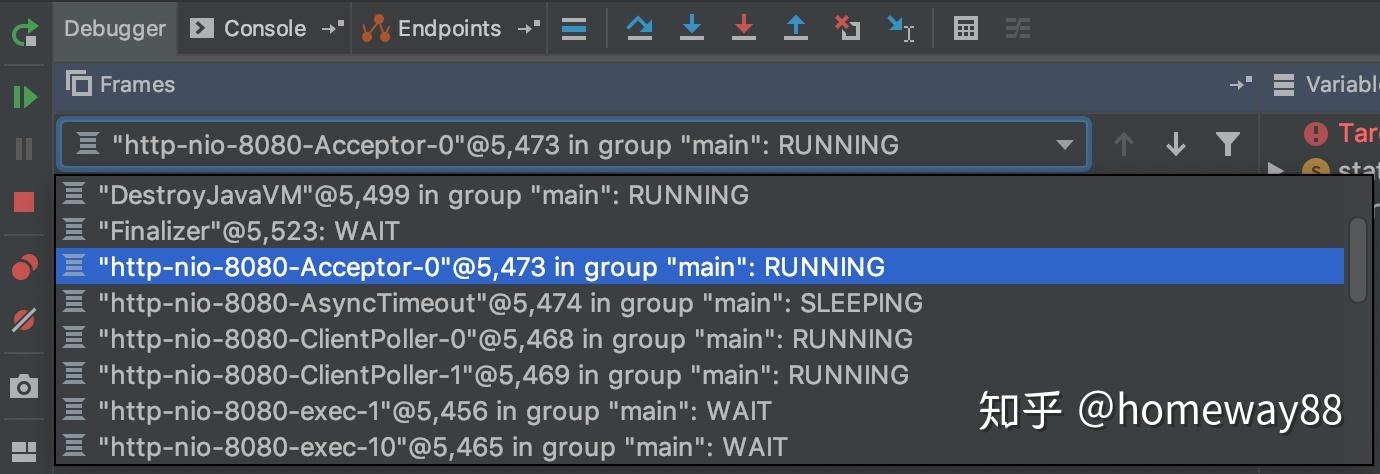三行代码带你了解Tomcat的基本原理
毕业工作以来,一直在做跟Web相关的后端开发工作,也自称Web全栈工程师,虽然很多时候都在写CURD,对于一直在用tomcat和
Spring Mvc
也未真正深入了解过,趁国庆假期,看了一下tomcat的架构和代码,并对代码运行过程进行了跟踪,基本理清了它的原理和运行过程。
对于一次http的请求过程,无非是客户端跟服务端建立一个TCP连接,然后跟服务端发起一次GET/POST请求,服务端再返回对应的数据。这是简化之后的请求过程:

那么,怎么实现这个程序呢?最简单的,应该有一部分,是负责底层的Socket连接与请求报文的数据解析,这块是tomcat的工作,然后将这个请求,再转给SpringMvc进行处理,SpringMvc根据请求路径,Dispatch到这个路径绑定的处理函数去处理,并返回数据,再由tomcat输出给客户端。那么,顺着这个思路,我下面这一过程进行跟踪,看是否跟自己的设想吻合。
0.准备工作
学习一个软件,最好的方法就是把它跑起来,并找到一条线索,打断点进行跟踪调试,这里我利用
Spring Initializer
初始化一个带有
Spring Web
的
Spring Boot
工程,下载后用
IDEA
打开,并在程序入口处增加了一个api,总共三行代码,然后直接DEBUG运行即可。
@RequestMapping("/")
@ResponseBody
public String home(@RequestParam("name") String name) { return "Hello " + name; }
1. 分析过程
1.1 Tomcat对Socket连接的处理
程序运行起来之后,我们先将程序暂停一下,先分析一下,目前有哪些线程,并且这些线程停在哪里,可以看到有以下几个比较重要的线程,我们来逐个分析一下:

1.1.1 `http-nio-8080-Acceptor-0`
//org.apache.tomcat.util.net.NioEndpoint
protected class Acceptor extends AbstractEndpoint.Acceptor {
@Override
public void run() {
while (running) {
//...
try {
SocketChannel socket = null;
try {
// Accept the next incoming connection from the server
// socket
socket = serverSock.accept();
} catch (IOException ioe) {
//...
// Configure the socket
if (running && !paused) {
// setSocketOptions() will hand the socket off to
// an appropriate processor if successful
if (!setSocketOptions(socket)) {
closeSocket(socket);
} else {
closeSocket(socket);
} catch (Throwable t) {
可以看到,这里最重要的代码就是
serverSock.accept();
,这里是tomcat接受客户端连接的入口,获取socket之后,再通过
setSocketOptions(socket)
将这个socket交给Poller线程;
1.1.2 `http-nio-8080-ClientPoller-0`
//org.apache.tomcat.util.net.NioEndpoint
public class Poller implements Runnable {
* The background thread that adds sockets to the Poller, checks the
* poller for triggered events and hands the associated socket off to an
* appropriate processor as events occur.
@Override
public void run() {
// Loop until destroy() is called
while (true) {
boolean hasEvents = false;
try {
if (!close) {
if (wakeupCounter.getAndSet(-1) > 0) {
//if we are here, means we have other stuff to do
//do a non blocking select
keyCount = selector.selectNow();
} else {
keyCount = selector.select(selectorTimeout);
} catch (Throwable x) {
Iterator<SelectionKey> iterator =
keyCount > 0 ? selector.selectedKeys().iterator() : null;
// Walk through the collection of ready keys and dispatch
// any active event.
while (iterator != null && iterator.hasNext()) {
SelectionKey sk = iterator.next();
NioSocketWrapper attachment = (NioSocketWrapper)sk.attachment();
// Attachment may be null if another thread has called
// cancelledKey()
if (attachment == null) {
iterator.remove();
} else {
iterator.remove();
processKey(sk, attachment);
}//while
}//while
这里比较重要的就是
keyCount = selector.select(selectorTimeout);
,接受acceptor的socket,然后再调用
processKey(sk, attachment);
,将socket传给worker线程进行处理
1.1.3 `http-nio-8080-exec-0`
//org.apache.tomcat.util.net.NioEndpoint
protected class SocketProcessor extends SocketProcessorBase<NioChannel> {
@Override

